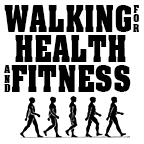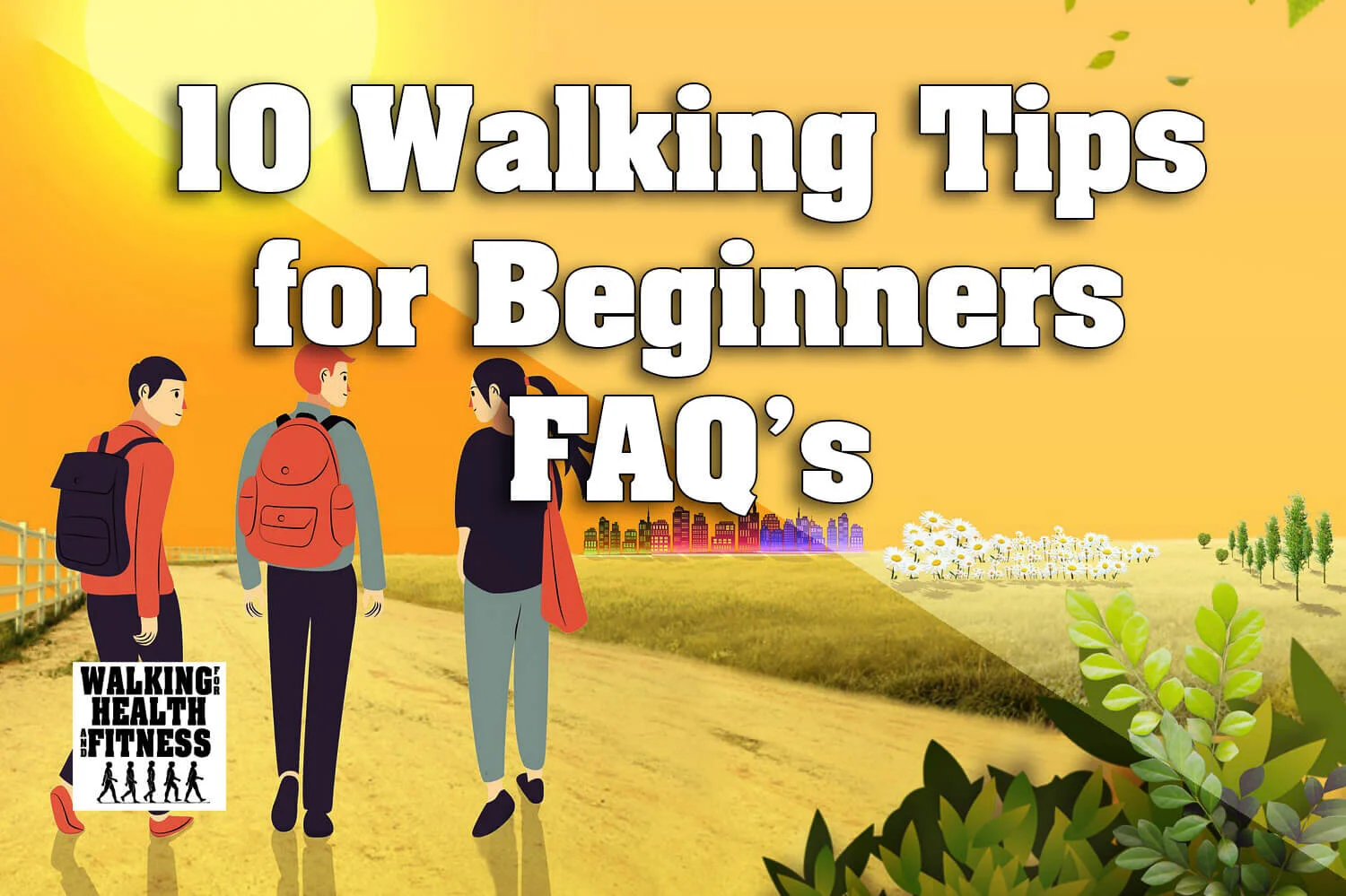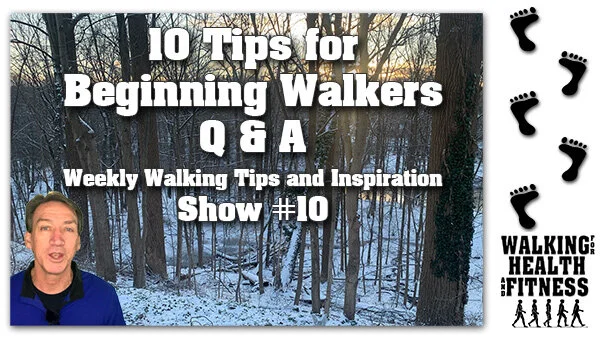Here are the 10 walking tips for beginners based on questions I’ve received through email, from viewers of my YouTube Channel, and readers of my walking books and website.
10 Walking Tips for Beginners, Frequently Asked Questions (FAQ’s):
1. IS WALKING GOOD FOR YOUR HEALTH AND FITNESS?
YES! Study after study shows us that walking and walking speed are linked to longevity. Walking speed predicts life expectancy of older adults.
A new analysis of walking speed studies shows that—down to the tenth of a meter per second—an older person's pace, along with their age and gender, can predict their life expectancy just as well as the complex battery of other health indicators.
So instead of a doctor assessing a patient's blood pressure, body mass index, chronic conditions, hospitalization, smoking history, and use of mobility aids to estimate survival, a lab assistant could simply time the patient walking a few meters and predict just as accurately the person's likelihood of living five or 10 more years—as well as a median life expectancy.
Your body self-selects your walking speed that best accommodates all of the systems that are needed to walk.
And although walking might seem like a simple mode of locomotion, it is a biologically complex endeavor, which integrates the circulatory, respiratory, skeletal, muscular, and nervous systems.
Walking—or gait—speed is "a powerful indicator of vitality," says Stephanie Studenski, a professor at the University of Pittsburgh's Division of Geriatric Medicine and co-author of the new analysis. "We just didn't use it in health care or public health."
Research by Studenski and her colleagues had found that people whose gait speed improved over the course of a year did have an increased rate of survival. But, she says, "we are not saying people should go out and walk faster." Because there have been no clinical trials offering fast walking as an intervention, a quick pace is not a proven panacea for living longer.
Many other studies have, however, found that walking helps lower blood pressure, keep weight down and improve mood. Substantial amounts of walking have also been linked to slower memory decline and reduced risk of some cancers.
The bottom line is as a beginning walker, take notice of how fast you walk. There are many apps available such as Map My Walk or Strava (use the Runner setting as it gives you more information.) that will calculate your pace.
If you are feeling well but your pace has slowed down, then it might be the early warning sign of a more significant problem.
The sooner you get this condition identified, the quicker you can recover and get back to walking.
For more information read: Increase Average Walking Speed
2. Can I really get in shape by just walking?
YES! I cannot stress this point strong enough. Walking will get you in great shape.
Walking tones your leg and abdominal muscles– and even arm muscles-- if you pump them as you walk.
Pumping your arms increases your range of motion, shifting the pressure and weight away from your joints and muscles, which are meant to handle the weight, helping to lessen arthritis pain.
Walking can help you burn fat and lose weight. When you walk for more than 45-minutes at a brisk pace, your body must burn stored fat. This helps you to lose weight, and excess body fat.
For more information read: How to Breath While Walking for Better Health
3. How Often Should I Walk?
Studies have shown that getting an hour a day of walking will give you the greatest longevity benefit.
To get in more walking time:
Walk in the morning, at lunchtime, and dinnertime for at least 10 minutes or more.
Walk to a local destination instead of driving.
Park your car a few blocks from your job or other destinations.
Schedule 20 to 30-minute sessions on a treadmill if you have access on one.
Window-shop at the mall, especially during the cold winter months.
For more walking information:
Looking to start walking for health and fitness but don't know how to start?Check out our walking program that’s guaranteed
to get you out the door<<
4. Do I Need Any Special Equipment for Walking?
No! Just a good pair of sneakers and comfortable clothes. Once you get into the walking habit, an investment in a shoe that is designed for walking is well worth the price.
Basically, it's the old axiom of having the right tool for the job. Walking shoes are designed with the specific body mechanics and strike path of walking in mind.
They are constructed to be more flexible through the ball of the foot to allow a greater range of motion through the “roll” of the forefoot. They also have greater arch support to protect where the force is heaviest on the foot.
Running shoes, in contrast, have more cushioning in the heel–the point of impact–and less protection through the ball of the foot.
Walking shoes are lightweight and so comfortable.
Picking the proper shoes can prevent discomfort, injury, and will encourage you to maintain an active lifestyle.
It is most important that your shoes feel comfortable so that you do not avoid exercising.
When purchasing a walking shoe, go to a shoe store where you can get your feet measured and have the shoe properly fitted. Then walk around the store for a few minutes to make sure they fit right and feel comfortable.
Here's an easy way to start walking for your health and fitness. Check out my Pleasure Walking Exercise Program. Walk your way to great health and fitness in just 30-minutes and 52-seconds!
5. Where Should I Walk?
Anywhere! Begin somewhere flat and gradually begin walking up hills to your walk to increase your heart rate and exertion.
Parks with walking paths or tracks are a great place to begin.
I recommend having several different routes of varying terrain. Variety is the spice of life.
I have go to routes that are hilly, flat, long, short, and everything in between.
Use Google earth to scout out different area nearby. I like walking to a destination such as a coffee shop or park. <in the video.. show google earth zoom in>
For more idea for walking destinations:
Get your Free Copy of my Exclusive Get Out the Door Checklist… and other goodies!
Athletes, even professionals, say the toughest part of any workout is getting out the door and getting started. Make your process automatic with my checklist!
6. How Many Calories are Burned by Walking?
Your weight and distance walked are the biggest factors in how many calories are burned while walking. For example, a 120 lb. person will burn 200 calories walking for 1 hour while a 180 lb. person will burn 300 calories.
WebMD.com has an excellent calorie burn calculator that asks you about your walking speed, terrain, weight, and the duration of the walk. The link to this Calorie burn calculator is in the description.
7. How can I Increase the Benefits of Walking?
Add push-ups, squats, planks, or lunges and your calorie burn will be even higher although not as high as you may think.
If you do 100 pushups during a 1-hour walk, you will burn approximately 35 more calories as it takes only 5 minutes combined to do 100 if you break it down to 5 sets of 20. BUT…in the long run, developing muscle by doing pushups will add so much to your fitness level. And the calorie burn continues after you have done what I call a walking workout.
My book: Fitness Walking and Bodyweight Exercises has all the benefits of doing a fitness workout while you walk.
8. On Which Side of the Road Should I be Walking?
ALWAYS WALK FACING TRAFFIC!
You want to see what is coming at you. Think about the number of distractions drivers face, cell phones, screaming kids (sometimes), sleep deprivation (an all too common accident factor), and a host of other reasons.
You want to see the approaching car and be able to take evasive action should a driver get too close for comfort.
If you don’t remember anything else from this post… remember this… always walk facing traffic!
More Walking Safety Videos:
9. Is it Safe to Listen to Audiobooks and Music When Walking?
Absolutely yes. Just keep the volume at a reasonable level to hear what’s going on around you and to protect your hearing in general!
Walking and Audiobooks: Mind-body connection.
Listen to audiobooks will add an amazing element to your walking habit. The miles will just float by when you get caught up in a good book.
Recent studies have shown a connection between the exercise and the brain. Exercise increases the size of the hippocampus which is involved in the formation of new memories and associated with learning and emotion.
The brain literally grows each time you exercise. Physical activity stresses our brain in the same way that it stresses our muscles.
Like active muscle fibers, neurons of the brain break down then recover to become stronger and more resilient with exercise.
Also:
10. How Much Water Should I Drink During My Walks?
Being properly hydrated begins before walking out the door. You lose water through breathing and sweat. You should drink water before you begin your walk. If you start out dehydrated, you may begin to feel dizzy and lethargic at some point during a walk especially in hot weather.
Whether you walk in warm or cold weather… you should always be well hydrated, it’s just a good health habit to get into.
How much water should you drink?
One to two hours before your workout, drink 15 to 20 ounces of water
15 minutes before you begin, drink between 8 and 10 ounces of water
During your walk, sip from your water bottle often.
If it’s hot out and you are sweating then, aim to drink 8 ounces every 15 minutes.
Carrying a fanny pack is a great way to carry water.
More Water Benefits:
For a complete overview of the benefits of walking for health and fitness, read: Walking for Health and Fitness (first blog post)
Walk on,
Frank S. Ring
Author: Walking for Health and Fitness, Fitness Walking and Bodyweight Exercises, and Walking Inspiration.
Are you ready to take the first step and leave the sedentary lifestyle behind and embrace a healthier, more active you? Download my Walk Away from the Couch Guide.









